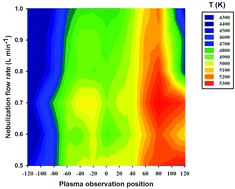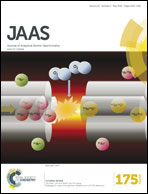Characteristics of a resonant iris microwave-induced nitrogen plasma†
Abstract
In this work, we use the Boltzmann plot, Saha's equation and the Mg II/Mg I signal ratio to determine temperature (T), electron number density (ne) and robustness of different regions of a microwave-induced nitrogen plasma. A 2-D profile based on plasma observation position and nebulization flow rate is generated for each of these properties and their effects on sensitivity, accuracy and matrix-related interferences in microwave-induced plasma optical emission spectrometry (MIP OES) are evaluated. Plasma temperatures vary between 4220 and 5360 K by changing nebulization flow rate and plasma observation position. These same instrumental parameters are varied to produce ne values in the 0.47–3.72 × 1013 cm−3 range, and Mg II/Mg I ratios between 0.26 and 2.01. Limits of detection (LODs) were calculated for different T and ne conditions, and for analytes with a wide range of Esum values (Esum = ionization energy + excitation energy). The best LODs were calculated for determinations at high ne plasma regions. More robust plasma conditions allowed for more accurate results when determining analytes with Esum > 9 eV or < 3 eV. For intermediate Esum elements, the best recoveries in complex sample analyses were obtained at high ne conditions. Although the microwave applied power is fixed at 1000 W for the commercial MIP OES evaluated, one can still control plasma conditions by varying other operating parameters, which may contribute to fewer matrix effects, better accuracies and lower LODs.


 Please wait while we load your content...
Please wait while we load your content...